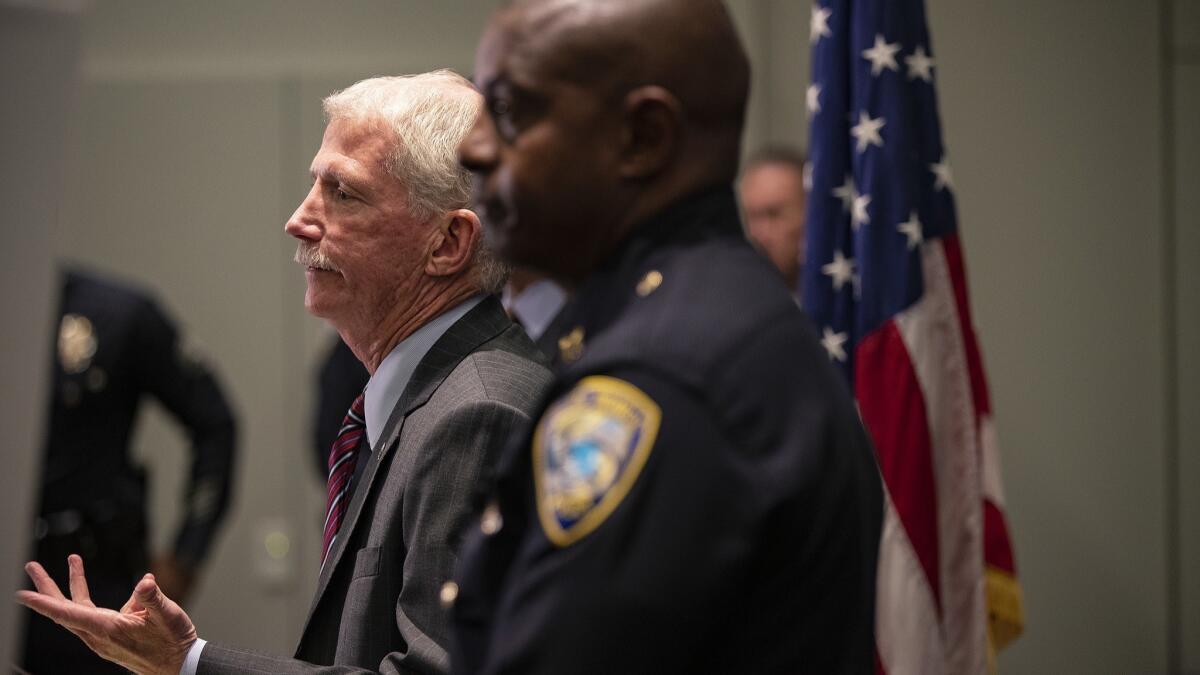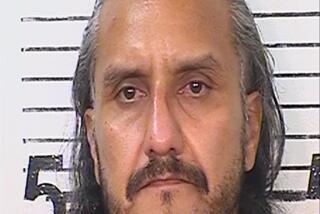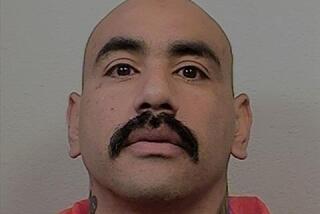Despite repeated deportations, suspect in homeless beating deaths cut a bloody swath across L.A., police say

Just days after his aunt and uncle were reported missing in Houston, Ramon Escobar got in his Honda CR-V and drove west.
The 47-year-old native of El Salvador traveled more than 1,500 miles along Interstate 10, stopping when he hit the Pacific Ocean on Sept. 5.
Three days later, Santa Monica police found a homeless man battered and bruised on the beach. Someone had beaten the victim, causing severe injuries to his head, as he slept.
Over the course of 17 days, police allege, Escobar would approach six other men the same way — sneaking up as they dozed in secluded areas, sometimes clutching a wooden baseball bat or a pair of bolt cutters.
Police believe Escobar cut a bloody swath across Los Angeles and Santa Monica, beating three men to death and seriously injuring four others in a series of vicious attacks that jolted the city’s vulnerable homeless population.
“It’s not just that people are being murdered. You hear of people being bludgeoned to death on city sidewalks,” said Mel Tillekeratne, executive director of Shower of Hope, which provides free mobile showers and other hygiene services to the homeless. “It breaks your heart.”
Investigators will seek to charge Escobar with murder in the deaths of Kelvin Williams, 59, Braden Ridout, 34, and Steven Ray Cruze Jr., 39, Capt. Billy Hayes, who heads the Los Angeles Police Department’s Robbery-Homicide Division, said at a downtown news conference.
Escobar will also face attempted murder charges in attacks on four homeless men in Santa Monica and Los Angeles that took place from Sept. 8 to 24, Hayes said. Three of those men remain in critical condition, police said. Police said surveillance video and other forensic evidence linked Escobar to most of the attacks.
Hayes said the LAPD is contacting authorities in cities along the route from Houston to determine if other similar attacks could be connected to its investigation.
“He is a violent predator,” Hayes said.
Escobar has a lengthy criminal record that includes arrests for assault, burglary and trespassing in the Houston area, court records show. He was imprisoned in Texas from 1995 to 2000 after a burglary conviction, Hayes said. In one of those cases, records show, a judge questioned Escobar’s competency to stand trial.
“Nobody in their right mind would do something as vicious as this,” Hayes said, adding that he believed Escobar was culpable for his alleged actions.
Hayes described Escobar as a “previously deported felon,” but did not know exactly when he had been removed from the country or why. At some point, Escobar was allowed to return to the U.S. as an asylum seeker. Hayes could not say exactly when Escobar gained reentry to the country.
Late Tuesday, U.S. Immigration and Customs Enforcement said Escobar was ordered removed from the U.S. by a federal immigration judge in February 1988, and was deported to El Salvador six times between 1997 and 2011. ICE said Escobar has six felony convictions for burglary and illegal reentry.
“After illegally reentering the U.S. following his most-recent removal, [Escobar] filed an appeal of his immigration case ... in June 2016, which the courts granted in December 2016. ICE released him from custody on an Order of Supervision in January 2017 pursuant to the court’s decision.”
While nearly all of the attacks involved homeless victims, Hayes said detectives believe Escobar was targeting isolated victims so he could rob them, not specifically because they were homeless. Surveillance footage showed the assailant rummaging through his victims’ pockets in some of the attacks.
Police also searched the vehicle Escobar brought west, where they found blood and the baseball bat they believe was used to kill Williams and Ridout in downtown Los Angeles, Hayes said.
Both men were beaten to death as they slept in the Financial District on Sept. 16, Hayes said. Four days later, Cruze was sleeping under the Santa Monica Pier after a fishing trip when he was pummeled by the attacker, authorities said.
Cruze was not homeless, according to his family, but sometimes slept on the beach between shifts on a commercial fishing boat in Santa Monica.
“He was doing what he wanted to do in life, and somebody took his life from him,” said the victim’s uncle, Steven Smith.
Escobar is also considered a person of interest in the disappearance of his aunt and uncle, Dina and Rogelio Escobar, Houston Police Chief Art Acevedo said. The brother and sister were last seen in late August, Houston Police Lt. Humberto Lopez said.
Rogelio Escobar, 65, was last seen near a convenience store in Houston on Aug. 26 and left a backpack on the porch of his Prudence Drive home the same day, Lopez said. Dina Escobar, 60, went looking for her brother in a 2007 Chevy Uplander and was reported missing days later, Lopez said.
Lopez said foul play is suspected in their disappearance. The charred remains of Dina Escobar’s vehicle were found on a beach in Galveston, roughly 50 miles outside of Houston, earlier this month, according to Tim Miller, the founder of Texas Equusearch, a horseback rescue group that aids in the search for missing persons. His organization has been involved in the search for Dina and Rogelio Escobar since late August.
Escobar sometimes lived with his missing uncle, Rogelio, but would disappear for days at a time to seek work as a day laborer, Miller said. Houston police said Escobar fled the area before detectives could question him in connection with his relatives’ disappearance, Lopez said.
He arrived in Santa Monica on Sept. 5, Hayes said. A pattern of brutal attacks against homeless man began just days later.
On Sept. 8, Escobar allegedly attacked a homeless man sleeping on the beach around 6:45 a.m., according to Santa Monica Police Capt. Wendell Shirley. Two days later, another homeless man was found with severe head injuries in the same area, Shirley said.
One of those victims has since been released from the hospital, but the other is in a coma, Shirley said.
Six days later, Escobar was caught on surveillance cameras roaming the downtown Financial District with a baseball bat. He smashed three men across the head with the weapon as they slept along Flower Street from 4 to 5 a.m., police have said. Williams and Ridout died of their injuries days later, and a third victim remains in critical condition.
The savage assaults drew a swift response from the LAPD, as officers began scouring homeless encampments in the downtown area and passing around fliers with Escobar’s picture, which was captured by an area surveillance camera.
Four days later, police say, Cruze was sleeping under the Santa Monica Pier when Escobar attacked. The 39-year-old San Gabriel man’s body was found beneath the pier around 6:40 a.m. Sept. 20, police said.
Smith, the victim’s uncle, said Cruze is survived by two children and spent his life working on whale watching and fishing boats in Santa Monica and Marina Del Rey. Smith said his nephew was hoping to one day save up enough money to be the captain of his own tour boat.
“He loved everybody and didn’t have a bad bone in his body. He has so many people that he fished with on the pier … he had no issues with nobody,” Smith said.
Shirley said police found another homeless man who had suffered blunt force trauma to the head near 7th Street and Broadway about 7 a.m. Monday. An officer recognized Escobar, who is bow legged, from surveillance images released by the LAPD in relation to the downtown killings, and arrested him without incident.
The string of assaults sparked panic among the region’s sprawling homeless population, said Tillekeratne of Shower of Hope. As recently as Monday, Tillekeratne said some members of the skid row homeless community told him they were afraid they had spotted the suspect in the downtown attacks milling around the area.
“They saw a person that fit that bow-legged description and they were terrified,” he said.
Tillekeratne said the brutal nature of the recent killings drew media attention because of its proximity to downtown’s bar scene and night life but warned that the attacks are illustrative of the everyday dangers faced by a community he feels is chronically underserved by the city.
“How do we protect these people who are constantly exposed to the worst forms of violence you could ever think of?” he asked.
Times staff writer Cindy Chang contributed to this report.
Twitter: @JamesQueallyLAT
Twitter: @LAcrimes
More to Read
Sign up for Essential California
The most important California stories and recommendations in your inbox every morning.
You may occasionally receive promotional content from the Los Angeles Times.











